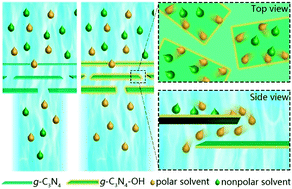Manipulating the cross-layer channels in g-C3N4 nanosheet membranes for enhanced molecular transport†
Abstract
Two-dimensional (2D) lamellar membranes with well-defined channels show great promise in molecular separation. The mass transfer paths include both interlayer and cross-layer channels; however, previous studies mainly focused on interlayer channels. Herein, g-C3N4 nanosheets with various lateral sizes and thicknesses were edge-functionalized by hydrophilic (–OH) or hydrophobic (–OOCCH3) groups and utilized as building blocks for lamellar membranes. In this way, the hydrophilicity, length, and thickness of cross-layer channels were subtly tuned. We demonstrated that the cross-layer channels display a ‘gate effect’ to govern molecular selectivity while the interlayer channels determine the molecular transport rate. Membranes with hydrophilic/hydrophobic heterostructured channels acquire highly elevated polar solvent permeance and polar/nonpolar solvent selectivity, and this ‘gate effect’ can be intensified by increasing the thickness and total length of the cross-layer channels. The acetonitrile permeance and acetonitrile/toluene separation factor reach as high as 2128 L m−2 h−1 bar−1 and 12.7, respectively. This study may represent the first example to identify the contribution of cross-layer channels within lamellar membranes, paving a way to designing efficient 2D nanochannel membranes.



 Please wait while we load your content...
Please wait while we load your content...